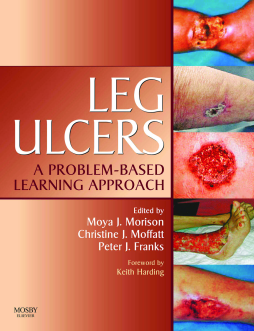
Additional Information
Book Details
Abstract
Using a unique problem-based learning approach, this comprehensive, full-color reference features case studies that link theory to practice. Chapters are written by an international group of 35 contributors and edited by a team of U.K. experts. The depth and scope of the material makes this an ideal core reference text, and an excellent resource for both nurses and medical staff involved in the management of leg ulcers.
- A comprehensive approach incorporates up-to-date clinical information.
- Problem-based learning allows readers to learn through real-life situations relevant to their clinical area.
- Reflective case studies encourage readers to explore new ideas and challenge the basis of their practice.
- Sources of knowledge chapter assists readers in identifying up-to-date sources of information to enhance their professional practice.
Table of Contents
| Section Title | Page | Action | Price |
|---|---|---|---|
| Front Cover | Cover | ||
| Leg Ulcers: A problem-based learning approach | iii | ||
| Copyright Page | iv | ||
| Contents | v | ||
| Contributors | vii | ||
| Foreword | ix | ||
| Preface | xi | ||
| Acknowledgements | xii | ||
| SECTION 1: INTRODUCTION | 1 | ||
| Chapter 1. What is problem-based learning? | 3 | ||
| Chapter 2. Sources of knowledge, evidence-based practice and the development and effective use of reflective portfolios to enhance professional practice | 13 | ||
| Chapter 3. How to make the most of this book | 37 | ||
| SECTION 2: CASE STUDIES | 41 | ||
| A simple venous ulcer | 43 | ||
| Non-healing venous ulceration | 44 | ||
| Complex venous/lymphatic ulceration | 45 | ||
| An arterial ulcer progressing to below knee amputation | 47 | ||
| Mixed venous/arterial ulcer | 48 | ||
| Arterial ulceration in a patient with rheumatoid | 49 | ||
| A neuropathic diabetic foot ulcer | 51 | ||
| An ischaemic diabetic foot | 52 | ||
| An ulcer due to Waldenström’s cryoglobulinaemia | 53 | ||
| Malignancy in a long-standing venous ulcer | 55 | ||
| An ulcer associated with pyoderma gangrenosum | 56 | ||
| An ulcer associated with tuberculosis | 57 | ||
| An ulcer associated with sickle cell disease | 58 | ||
| A tropical ulcer (yaws) | 59 | ||
| A self-inflicted ulcer | 60 | ||
| SECTION 3: LEG ULCER MANAGEMENT: PRINCIPLES AND RESOURCES | 63 | ||
| Chapter 4. Epidemiology | 65 | ||
| Chapter 5. Health economics | 75 | ||
| Chapter 6. Models of service provision | 99 | ||
| Chapter 7. A framework for patient assessment and care planning | 119 | ||
| Chapter 8. Causation of venous leg ulcers | 141 | ||
| Chapter 9. Venous ulcers: patient assessment | 155 | ||
| Chapter 10. Compression therapy in leg ulcer management | 169 | ||
| Chapter 11. Surgery and sclerotherapy in the management of venous ulcers | 199 | ||
| Chapter 12. Surgical treatment to cover skin defects, including skin grafting and tissue extension | 213 | ||
| Chapter 13. An overview of pharmacological treatment options for venous ulcers | 223 | ||
| Chapter 14. Lymphoedema of the lower limb: causation, assessment and management | 243 | ||
| Chapter 15. Arterial ulcers: theories of causation | 261 | ||
| Chapter 16. Ischaemic ulceration: investigation of arterial disease | 269 | ||
| Chapter 17. Leg ulers associated with arterial insuficiency: treatment | 289 | ||
| Chapter 18. The diabetic foot | 313 | ||
| Chapter 19. Malignancy, including surgical treatment | 329 | ||
| Chapter 20. Inflammatory ulcers | 339 | ||
| Chapter 21. Tropical ulcers | 357 | ||
| Chapter 22. Leg ulcers in sickle cell disorders | 383 | ||
| Chapter 23. Wound bed preparation for venous leg ulcers | 391 | ||
| Chapter 24. Skin substitutes | 399 | ||
| Chapter 25. Wound infection | 413 | ||
| Chapter 26. Adjuvant therapies: ultrasound, laser therapy, electrical stimulation, hyperbaric oxygen and vacuum-assisted closure therapy | 429 | ||
| Chapter 27. Dermatological aspects of leg ulcers | 453 | ||
| Chapter 28. Nutritional assessment and support | 461 | ||
| Chapter 29. Principles of best practice minimizing pain at wound-dressing-related procedures: a consensus document | 489 | ||
| Chapter 30. Health-related quality of life with chronic leg ulceration | 501 | ||
| Chapter 31. Psychological aspects of wound healing | 529 | ||
| Chapter 32. Health promotion and patient education | 543 | ||
| Index | 559 |
